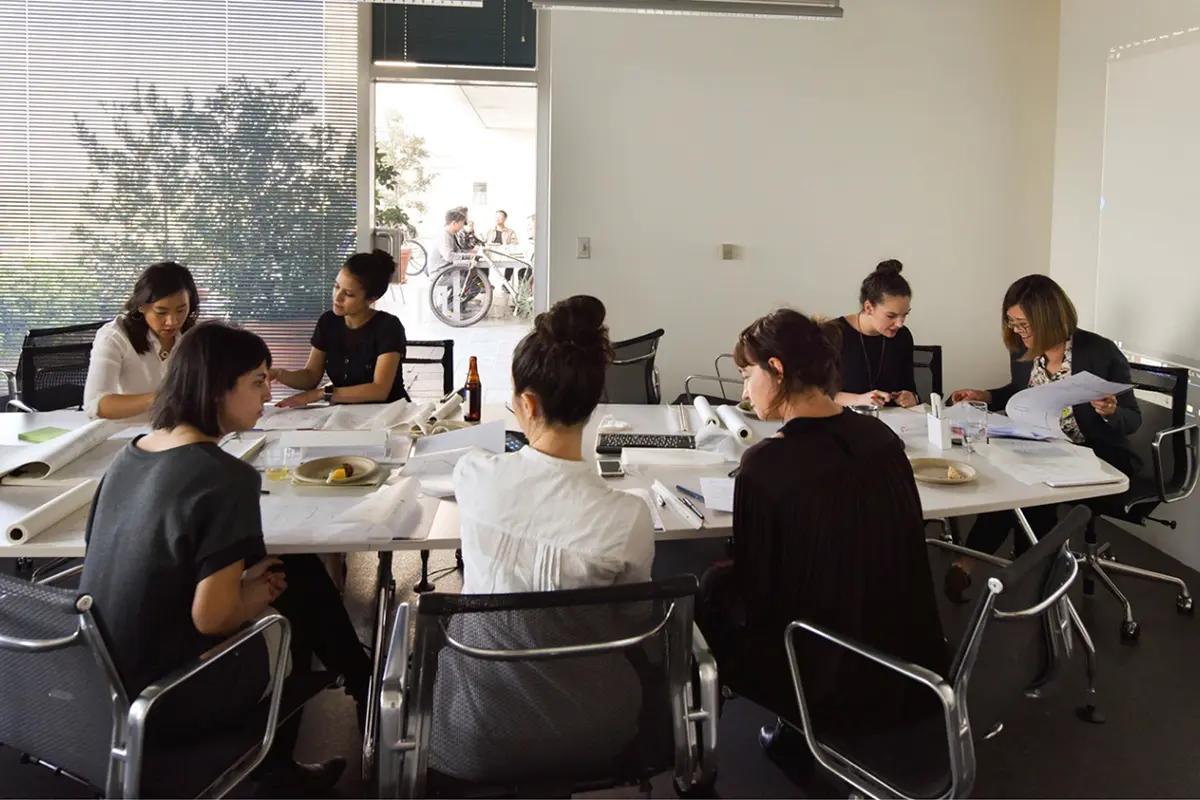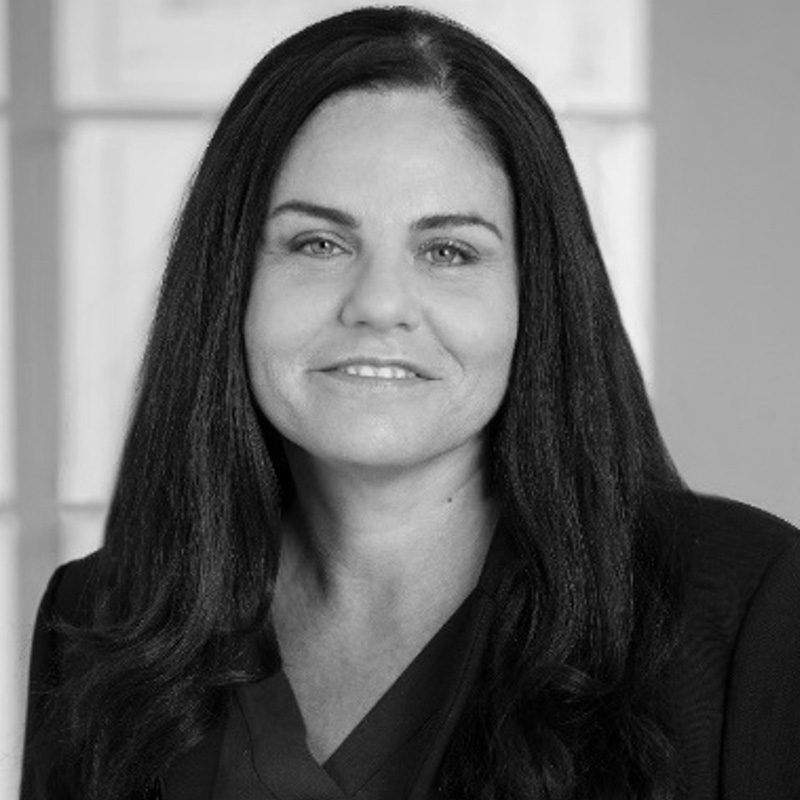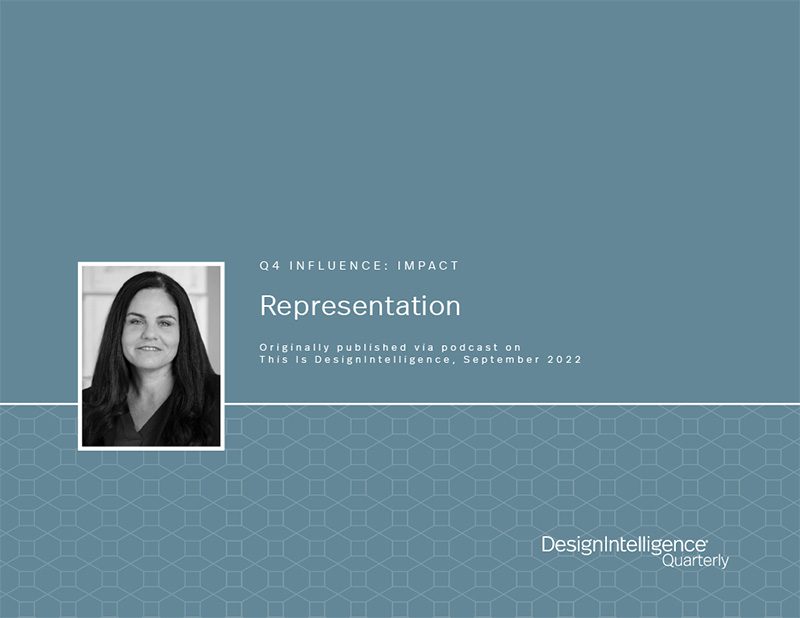Representation
by Jenna Knudsen, AIA
Managing Principal, CO Architects
November 2, 2022
Excerpts from a This is DesignIntelligence Podcast published in September 2022
In this interview with DI’s Bob Fisher, CO Architects’ Jenna Knudsen discusses how to build firm culture broadly for greater impact
DesignIntelligence (DI): Jenna, welcome to “This is DesignIntelligence.” Thanks for agreeing to spend some time with us.
Jenna Knudsen (JK): Thanks for having me.
DI: We’re honored to have you. You are the managing principal at CO Architects in California. The press release that announced your promotion said you are both the youngest architect to hold that position and the first woman. Tell us about your journey and how you wound up becoming managing principal of CO Architects.
JK: What drew me to architecture was an interest in trying to create a floor plan for my large family, where everyone, myself specifically, could have their own room. In doing that, my father recognized an interest and encouraged and supported architecture as a profession. Since I was about 10, I have said I wanted to be an architect. I went to USC when I was 18 and studied architecture. My first job was at CO Architects. We were Anshen & Allen Los Angeles at the time, but the work was largely in the same markets we work in today. Our expertise was healthcare, higher ed, science and technology and civic work. The first project I worked on out of school was a major replacement hospital. I was drawn to the complexity of the problem in healthcare and the great need for good design in a building type whose occupants could benefit from it.
I’ve spent a lot of my career in healthcare. I have also worked across many of our other project types in laboratories and health sciences, and education work. I appreciate the missions of the clients we work for. I appreciate the work done in those buildings, the important teaching and research and devotion to solving some of the world’s most pressing problems.
Organizationally, I have always been challenged at CO Architects. I’ve had many different roles over the years, in project types and internally within the organization. As a practice, we encourage initiatives that come from the staff, and I’ve been involved in many of those over the years. CO is where I have made my home and have always felt challenged. I always felt I had a voice and could bring forth an opinion about something I saw. That diversity of roles and responsibilities, years of tenure and an interest in the business of architecture are how I became managing principal. More importantly, they are reasons why I stay at CO Architects and continue to create the environment we have within the firm.
DI: You’ve been managing principal for about 18 months. If you could go back a few years to past Jenna and give her some advice based on what you know today, what would you tell her?
JK: Good question. I feel fortunate because the transition was thoughtful and I worked closely with my predecessor, the former managing principal, and continue to. He remains active in the practice. During the transition, even before we had formalized any kind of transition, we worked to understand what the role of managing principal meant, how he approached it, and how I might approach it differently. That set me up for success and I attribute his thoughtfulness to making that successful. I’m not sure I could have told myself these things 18 months or three years ago. A lot of it is learning by doing. I did feel well prepared, and in the day-to-day, I am still learning about what it means to be managing principal. But I’m not sure there’s something I could have told myself to be prepared for.
DI: There were a lot of surprises?
JK: I wouldn’t say surprises. Having been with the company, having been a principal and a leader for many years, and watching my predecessor in the position, I was well prepared, but you don’t know what you don’t know. Things come up in any given day. Each day is different. Any number of things can come across my desk or people coming into my office to chat about things. I’ve learned to carve out that time because I don’t know when something will require my attention.
DI: We’re at a point in history where a large generational shift is happening, and leadership transition is on the minds of many firms. Many struggle with it. You’ve painted a picture of a well-handled transition as you are assuming the managing principal role. What lessons would you take forward from your experience that others could emulate or that you might put in place when it’s time for you to transition a future managing principal?
JK: I agree, a lot of organizations are thinking about transition. Within the ethos of CO Architects, we value transition. It is something we constantly think about. We talk about ourselves as a firm in perpetuity. That concept is broadly held by many partners. There are 12 principals within the firm, and 21 shareholders. It’s never about one individual or any specific individuals. The approach is that we are the caretakers for the future generation. The name, CO Architects, means jointly or with, so we are not named after any partners past or present. That carries a way of thinking, that we should always be thinking about transition. When we are talking about transition, we are thinking about the next generation of leaders and actively growing many individuals within the organization to be able to be future leaders.
DI: Tell me about your approach to helping identify and develop future leaders.

Image Courtesy: CO Architects
JK: One aspect is the responsibility of all the principals in an organization of 165 people to rely on many leaders within the firm to identify individuals with specific talents and help mentor and cultivate them. The approach is to spend time with individuals, learn what people’s interests are, try to find opportunities for them to pursue those interests and passions and challenge them in other areas. One of the things I credit in my journey is that I usually said yes to opportunities presented to me, whether they were something I was seeking out or not. That often exposed me to different facets of the profession, introduced me to different people and organizations, internally and externally. Part of being a mentor and an advocate is to present opportunities to individuals they have perhaps not considered for themselves to see where that could take them.
DI: How would you describe the culture of mentorship at CO?
JK: It has many characteristics. We do have a formal mentorship program - one we have developed over years and continue to adjust as we receive feedback, but that works quite well and is pretty simple. It is formal in the sense that, even though it’s not required, one does need to sign up and fill out a brief questionnaire. It’s about your interests and who you think in the organization would make a good mentor for you in that year. It’s a one-year pairing. Beyond the formality of the pairing, the two individuals determine for themselves how they will engage. We do have a budget for it so people can go to lunch or coffee and that helps keep the program going. And because it’s for one year, people really appreciate that they can have many different mentors over their career.
At any given time, people have really thought about what they see in their immediate future and who would be a good mentor. That’s the formal mentorship program. We are very project-centric, all our principals, including myself, work on projects. Much of the mentorship occurs at a project level—formally teaching somebody how to be a project manager, guiding them in how to run a project, plus being an advocate for them with the client. Sometimes it’s simply the more technical components or design development of creating architecture.
DI: Let’s talk about diversity, equity and inclusion. It’s no secret - we work in a profession and in an industry that has not been terribly diverse. There’s been a lot of attention and effort to try to make positive change in that area. Tell us how this came to be a passion.
JK: I am passionate about the topic. For me, it was very much an evolution. It might help to go back a bit. I was encouraged to consider architecture from my father because he saw me having an interest. Through that, I was encouraged. I didn’t have any architects in my family nor any close relationships with architects, but it was a profession planted within me at an early age as an option. It never occurred to me that it was not an option as a woman to be an architect. When I went to school, it was not 50/50, but there were a number of women. As my career progressed, I did start to notice there were fewer women practicing.
My interest as a woman was trying to understand what is it about architecture that creates unique challenges for females. This aligned at a timely point with the conversation in the profession around equity. It’s a multifaceted issue, but it starts with representation. Women just were not exposed to the profession of architecture. As that has changed, it has created greater representation where women see other women in roles in architecture, including leadership roles, and that makes it possible.
There’s also an aspect of acceptance. The profession and the world have changed to the point where there’s a recognition that different approaches and styles within both design and leadership of architecture are beneficial. That more voices and differences can be of benefit. By including more women and underrepresented minorities, the profession and architecture have become richer. Finally, thinking about flexibility, women still carry a larger burden of responsibilities in the home. So, it’s been important to consider what that means and how architecture—and CO Architects, specifically—can be a place that recognizes that, a place where not just women, but parents or caretakers of any kind can work and also have families.
DI: There are a few different levels on which we could look at diversity, equity and inclusion. On an individual level, a team level, a firm level and on an industry level. What we have the most influence over, though, is our direct sphere. As managing principal at CO, what do you see as your role? What are you all doing and what are you personally doing to improve DEI at the firm?
JK: We’ve made significant advances in the past five to 10 years to the point where we are 50/50 men and women. A lot of that came with a simple approach in our hiring. We wanted to have broad representation of those participating in interviews, not just from our architectural perspectives (somebody deeply passionate about design or somebody deeply passionate about project delivery) but also to have gender representation within the interviews. In doing that, we still hired the candidates we felt were the best candidates. We just were able to hire more women. That made a significant difference.
Organizationally, we recognized the value of diverse voices. Not just in gender diversity, but in making sure we are a place where we make room for all voices. Often organizations have a culture, and that culture can perpetuate sameness. Everybody acts this way, or this is how we do things. We continually reinforce that good ideas can come from anywhere. There are different styles, and we need to make sure we are making room and encouraging everyone to participate in all aspects of the practice.

DI: When you have a diversity of viewpoints and a diversity of voices, that can lead to disagreements potentially. How does CO Architects manage these kinds of challenges?
JK: That becomes the responsibility of leadership. If we’re talking about within a project, for example, to make sure everybody knows the direction so we’re all rowing in the same direction. What are the project goals? What are the client’s goals? If we can agree on mission, vision and values, then working through the different ideas becomes a process of evaluating what is solving the problem in the best way and how are we best achieving alignment with that mission.
DI: On projects, if everybody agrees on a common set of goals, they have a common foundation. It seems there’s an analogy there to firm culture. How far off am I in thinking about it that way?
JK: You’re right on. I mentioned we have 12 principals and are a consensus-based organization. So, it is important that we are working together to hear the diversity of perspectives, but also come to a common understanding. Often, those conversations revolve around core values. Ultimately, the decision, once we put it through the lenses of core values and architecture, often becomes obvious to everyone.
DI: What are some of the lessons learned or biggest challenges you’ve faced in trying to help your firm be more diverse?
JK: Being in Los Angeles, we are fortunate that a diversity of candidates exists. We are fortunate that we can find good people who are also diverse. The challenge becomes to reinforce our intent to hire the very best people. That is our goal. That is what we do. That is what I believe we have here at CO Architects, and that includes a diversity of people.
DI: Do you feel the approach you have taken to diversity, equity and inclusion can be emulated by other firms? Where do other firms need to find their own approach and where can they embrace some common approaches, principles or ideas?
JK: There are lessons to be learned. Just having the representation in the process of hiring was critical. That may mean certain people are participating in more interviews, but that’s a simple approach we’ve seen have an impact and could for others. It’s having many conversations. It’s not a one-and-done conversation. Different people are at different levels of the conversation and are going to have diverse perspectives on how a firm would want to approach diversity, equity and inclusion. The most important thing is having the conversation within leadership, reaching out to other organizations who would also be having similar conversations and being okay that sometimes the conversations, while possibly uncomfortable, are important.
DI: CO Architects is well respected for large-scale academic laboratory and health care projects, and you do projects all over the country. Your clients are often institutions, and sometimes institutions don’t like to change, do things differently or move rapidly. How do you reconcile trying to bring diverse design voices into this kind of space?

For more from Jenna Knudsen, listen to the full This Is DesignIntelligence podcast interview
JK: Probably one of the most important things is that those institutions tend to be diverse. There are typically multiple clients and ultimately often a public entity, so a building for the public tends to have diverse representation. In that regard, that has not been a challenge. In fact, it’s been beneficial that the representation of CO Architects and our teams is representative of the community we live in and the communities with which we work.
DI: In many cases, it’s been natural?
JK: That’s exactly what it has been.
DI: How has the diversity of those who design within the firm changed design at CO Architects?
JK: The role of design leadership has evolved over the years. There is no singular author. The goal is to have many contributors. Yes, you need a design leader, setting direction, often editing, making sure there’s a cohesive whole, but most everyone who works in architecture got into it because they love design. So, the process needs to be inclusive.
DI: There’s a lot of talk and interest about creating more equitable environments. How do you define equitable environments and how do you go about creating them?
JK: My understanding of equity is that not every individual needs the same thing. It’s trying to meet people where they are, as opposed to equality, which means give everybody the same thing. If we’re considering equitable environments, what that means is understanding that any organization is made up of individuals and those individuals have different perspectives, different life experiences and different approaches. We try to cultivate that and generate an environment that doesn’t just accept, but also embraces, those differences.
DI: Jenna, thanks so much for joining us on “This is DesignIntelligence.” We really appreciate the perspective you’ve brought. It’s been great to be with you.
JK: Thank you very much for having me. I really enjoyed chatting with you.
Jenna Knudsen, AIA, LEED AP BD+C, is Managing Principal at CO Architects. She has led award-winning, large-scale academic, laboratory and healthcare projects on university and healthcare campuses across the country. Her groundbreaking projects demonstrate innovation in design, sustainability and project delivery—including early use of BIM and integrated project delivery, for which she has been nationally recognized. In addition to her leadership role in BIM adoption, she has continued to push for the use of tools such as computational design, virtual and augmented reality, and custom applications to advance the work. Within the practice and the profession, Jenna has been a long-time advocate for equal representation, spearheading initiatives to support and encourage women in architecture. Jenna received a Bachelor of Architecture from the University of Southern California (USC) and a Master of Science in Architecture and Urban Design at Columbia University.


